Adobe Commerce as Cloud Service (ACCS) – Magento Got Better?

For years, Magento has been both a powerhouse and a headache.
I mean, it offers limitless customizations, but again, it demands constant maintenance and disappoints when a business expands. Apart from that, merchants and developers are always needed to tackle complex upgrades, security patches, and performance bottlenecks.
Well, some of the merchants made it a practice but many of them chose to turn towards simpler SaaS platforms (like Shopify).
At this point, Magento needed to evolve, right?
“What if Magento could retain its flexibility while eliminating the pain of hosting, scaling, and constant upgrading?”
And yes, Adobe finally brought in the solution by announcing Commerce as Cloud Service (ACCS) !!! 🎊
This Adobe Commerce SaaS announcement has created a lot of confusion and a few are still floating everywhere.
People are wondering if this is Magento 3. Or… bigger than that?
In this guide, you’ll learn what exactly Adobe Commerce as a Cloud Service (ACCS) is and why it could be the biggest shift in Magento’s history. Let’s get into the details.
What is Adobe Commerce Saas (ACCS)?
Adobe Commerce SaaS, officially known as Adobe Commerce as a Cloud Service (ACCS), is Adobe’s new SaaS-based approach to eCommerce. Adobe Commerce required merchants to handle hosting, updates, security patches, and infrastructure. With ACCS, all of this is managed by Adobe in the cloud, offering a fully scalable and maintenance-free platform.
ACCS was announced in March 2025 at the Adobe Summit and is set for general availability in June 2025.
In simpler terms, this SaaS offering of Adobe will take full responsibility for these tasks in its own cloud environment.
This means businesses no longer have to worry about server maintenance, performance optimizations, or upgrading to the latest version as Adobe will manage everything behind the scenes.
Merchants can simply focus on growing their store while benefiting from a faster, more secure, and easily scalable eCommerce platform.
In short, ACCS takes the hassle out of managing Adobe Commerce stores by providing a SaaS-like platform that keeps Magento’s flexibility while making customization easier and more efficient.
At this point, you may even question this. 👇
# Is ACCS the same (or similar) as Adobe Commerce Cloud?
At first glance, Adobe Commerce Saas (ACCS) might sound like Adobe Commerce Cloud as they both cover [Adobe Commerce] + [Cloud Hosting]. However, they are different.
Adobe Commerce Cloud is a Platform-as-a-Service (PaaS) solution while ACCS is a Software-as-a-Service (SaaS) solution.
Okay, starting with base, Adobe Commerce Cloud’s current offering is that it hosts your Adobe Commerce store on its own servers. On these servers, merchants can upload their code that will reflect on both the front end (customer experience) and back end (admin panel).
Even when Adobe Commerce Cloud offers SaaS-like features (where it takes away the burden of hosting, scaling, and more), it’s not fully managed software. The platform still requires merchants to handle upgrades, performance optimization, and backend maintenance.
And in comparison, ACCS is fully managed by Adobe.
The main change in Adobe Commerce as a Cloud Service is that the core application code now stays locked and is only accessed by Adobe.
Adobe will manage everything as a true SaaS model.
This means merchants can no longer modify the database code directly, similar to Shopify’s infrastructure.
;
With that answer in the head, let’s also look through how it differs from the Magento & Adobe platform and their versions.
How does ACCS differ from Magento Open Source & Adobe Commerce?
ACCS is a Software-as-a-Service (SaaS) solution, while Adobe Commerce (formerly Magento Commerce) is a Platform-as-a-Service (PaaS) offering. Magento Open Source, on the other hand, is a self-hosted solution that requires full infrastructure management.
Okay, it was a lengthy sentence to get in. 🙃
Let’s understand their difference simply and in a detailed manner with a table comparison.
| Feature | Commerce as Cloud Service (ACCS) | Adobe Commerce Cloud | Adobe Commerce (On-Premise) | Magento Open Source |
| Solution Type | SaaS | PaaS | PaaS | Self-hosted (PaaS) |
| Hosting & Infrastructure | Fully managed by Adobe | Hosted on Adobe Cloud | Merchant chooses the hosting | Merchant chooses the hosting |
| Customization | Via app builder & APIs Quite limited compared to its self-hosted versions | Full access to the codebase | Full access to the codebase | Full access to the codebase |
| Pricing | Subscription-based | Custom Pricing (includes hosting) | License Fees + Hosting Costs | Free (but hosting cost adds) |
| Upgrades & Maintenance | Automatic, handled by Adobe | With some automation, the merchant manages updates | Merchants must manage updates | Merchants must manage updates |
| Security & Compliance | Automatic, handled by Adobe | Shared security responsibility | Shared security responsibility | Shared security responsibility |
| Scaling & Performance | Auto-scaled by Adobe | Auto-scaling available (Still requires manual configurations) | Depends on chosen hosting provider | Depends on chosen hosting provider |
| Frontend Approach | Fully headless (no Luma or Hyvä) | Can be headless or monolithic | Can be headless or monolithic | Can be headless or monolithic |
| Extensions & Custom Code | Uses “Apps” via App Builder | Traditional Magento modules & extensions | Traditional Magento modules & extensions | Traditional Magento modules & extensions |
| Who It’s For | Large businesses wanting low-maintenance | Enterprises needing flexibility with Adobe Cloud | Businesses needing flexibility & control | Developers & businesses wanting full customization |
And that shares a lot on what ACCS exactly is and how it differs from available Magento solutions.
Now that we know what Commerce as a SaaS service brings to the table, you want to know the reason Adobe introduced it.
Let’s understand that.
Why Did Adobe Introduce Adobe Commerce SaaS (ACCS)? Why Was It Needed?
As I said earlier, Adobe Commerce SaaS or Adobe Commerce as a Cloud Service (ACCS) is introduced to address the long-standing challenges merchants face with maintenance, scalability, and performance.
Many merchants using Adobe Commerce (formerly Magento) find it difficult to handle tasks like hosting, security updates, and performance optimization.
These tasks require technical expertise, and not all businesses have the resources or skills to manage them effectively.
Due to that, many of the eCommerce merchants were moving from Adobe Commerce to fully managed SaaS platforms like Shopify or BigCommerce. This is because they seek ease of use and reliability from the platform.
A major issue is that when things go wrong, merchants often blame Adobe Commerce as a platform.
(Calling it slow, outdated, or poorly optimized)
Well… Well… Well… In many cases, the real problem is not with Adobe itself.
Because every winning or failing factor depends on how the platform is implemented, configured, or hosted by the merchant or their development team.
Let’s consider a common scenario as an example.
“When a business with really high growth runs frequent flash sales, their site traffic jumps from thousands to millions of visitors within minutes. If their hosting nature and infrastructure in overall isn’t optimized to handle this spike, pages may load slowly, checkout might fail, or the site could crash. And this may lead to lost sales, revenue, and frustration among customers.”
Since Adobe doesn’t directly manage these aspects (in PaaS and on-premise setups), they’re not always responsible.
Yet, they still receive criticism.
& that was the reason Adobe introduced ACCS where they offer a fully managed SaaS platform along with the flexibility and advanced features of Adobe Commerce. And a few more advancements that we will talk about soon.
Having the control over infrastructure and performance, Adobe wants to lighten the load on merchants (and developers).
And, to eliminate infrastructure headaches, ACCS was clearly needed.
# How ACCS Expands Adobe Commerce’s Capabilities?
Adobe Commerce As a Cloud Service brings in the entire stake of Adobe Commerce as a SaaS platform.
And this new Adobe SaaS offering, in overall, brings out Adobe Commerce as a more scalable, intelligent, flexible, and cost-efficient platform for businesses that want fewer headaches on the technical side.
By adopting a cloud-native and SaaS-like model, ACCS will introduce greater performance, security, ease of use, and maintenance while reducing operating costs. At the same time, the platform will offer powerful capabilities, built-in, and better integration with existing Adobe solutions, making personalization, content management, and catalog management advanced and efficient.
Overall, ACCS will expand Adobe Commerce’s potential by providing its core commerce capabilities even better as a SaaS solution.
;
That was an overview of ACCS’s potential. Now, let’s learn what exactly it is bringing for you.
Key Features of Adobe Commerce as Cloud Service (ACCS) — What’s New?
Here, let’s check on what Adobe Commerce’s SaaS solution has for you.
1. Fully Managed Cloud Infrastructure
The Adobe Commerce SaaS solution will bring along a cloud-based hosting of Amazon Web Services (AWS).
Hosting complexities, server management, and infrastructure management will be under Adobe, where they take full responsibility for performance and security. So, merchants won’t have to worry about scaling, uptime, security upgrades, patch installation, or anything else in that matter.
Since Adobe Commerce SaaS runs entirely in the cloud, merchants can access and manage their stores from any web browser without relying on physical servers or complex IT setups.
This eliminates the need for on-premise infrastructure.
2. Adobe Edge Based Storefronts
With ACCS, the storefronts will be powered by Edge Delivery services with modern infrastructure to build a scalable and highly responsive frontend that performs well.
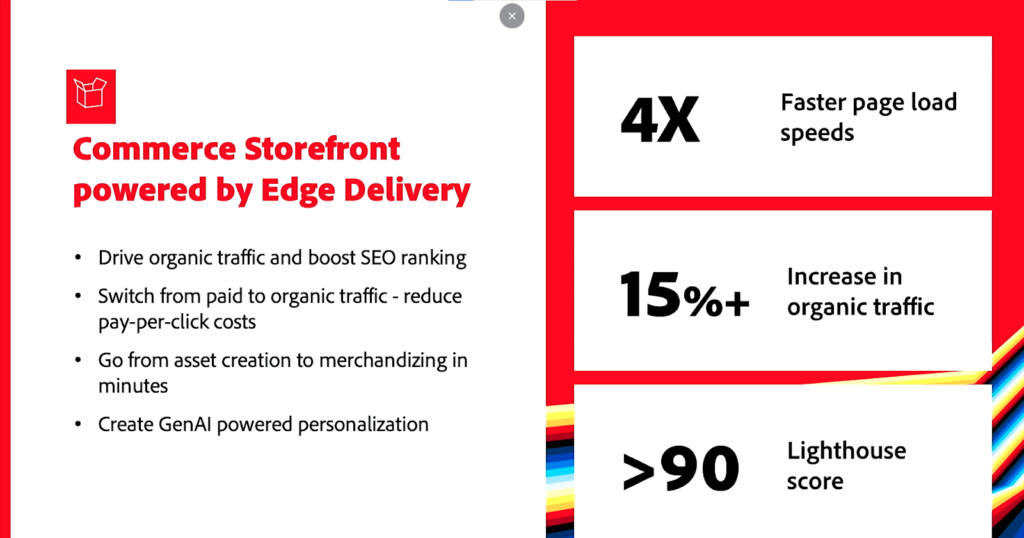
By running directly on the Adobe edge, these storefronts drastically reduce load times, allowing pages to load almost instantly.
This leads to higher Lighthouse scores (90+), which directly impact search rankings, making the store more discoverable on SERP. With faster page loads and improved SEO, businesses benefit from increased organic traffic and attract more relevant visitors, ultimately leading to better engagement and conversions.
When Adobe tested Edge-powered storefronts against traditional self-hosted setups, it scored 99 on Lighthouse. And that shows how Edge can help you gain a storefront with better speed and performance.
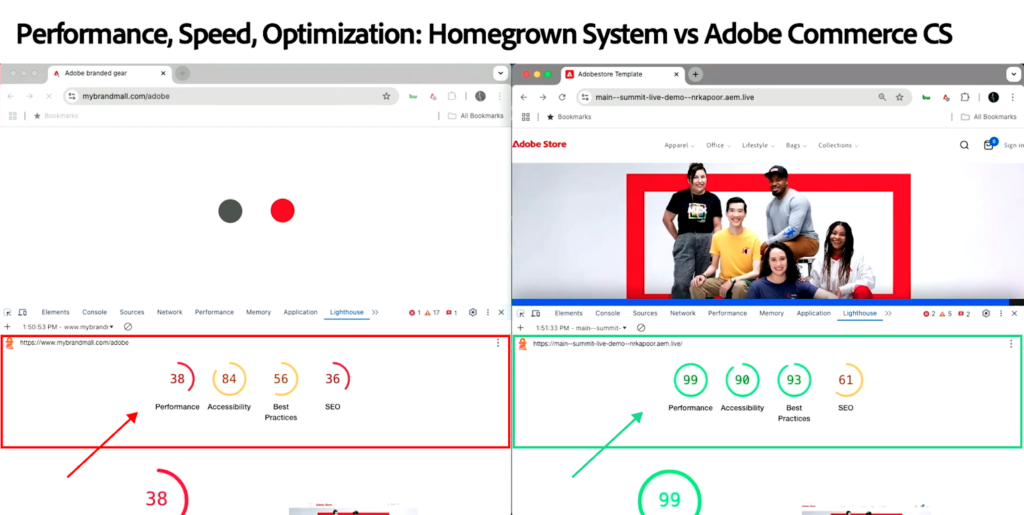
More than 30 VIP customers of Adobe have already seen very promising results through it.
One of them, LoveSac, switched to an Adobe Edge-powered storefront and saw:
- 2X increase in unbranded organic traffic
- 8% improvement in conversion rates
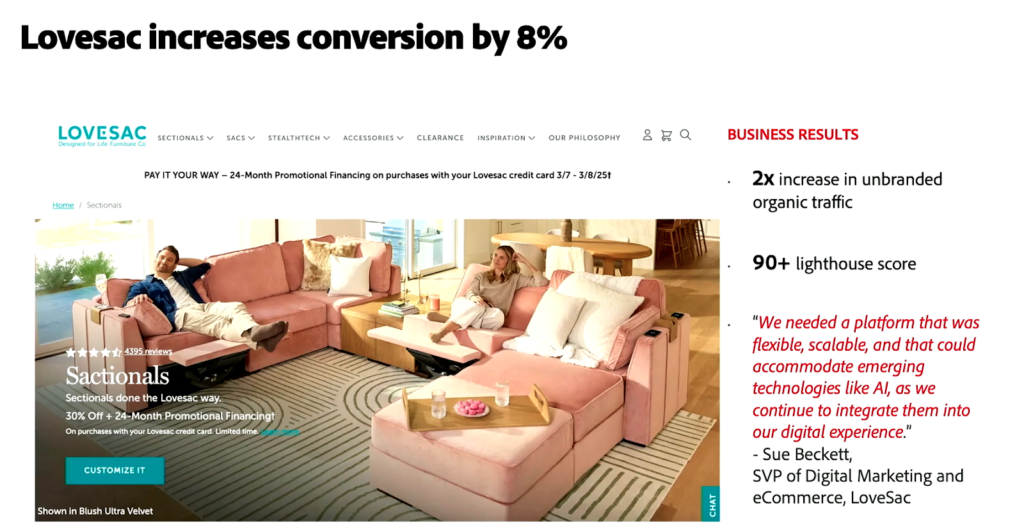
And that’s an impressive count for any eCommerce business.
3. AEM-Powered Content Management
For content management, Adobe Commerce Saas introduces a Universal Editor powered by Adobe Experience Cloud, providing advanced tools for content personalization, automation, and analytics.
The editor will bring together some exceptional content management capabilities to enhance storefront development.
Let’s talk about them section-wise.
# Visual Authoring
It will provide a flexible and dual-mode editing experience where it supports both document-based and visual-based authoring where anyone can create, edit, and manage content easier from a single screen.
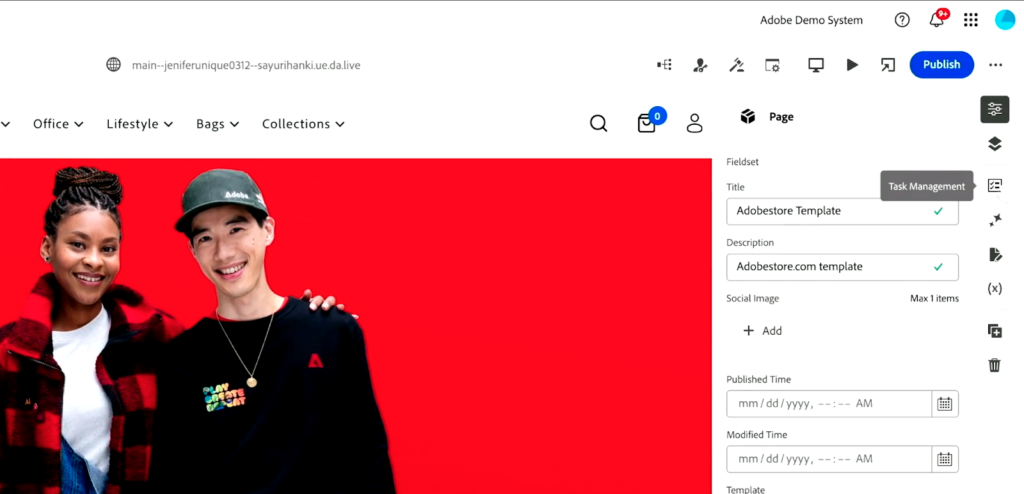
This universal editor by Adobe Experience Cloud in ACCS will have WYSIWYG capabilities that allow marketers, developers, and merchandisers to build their own builder to manage content with ease. This will allow them to create their own functionality, associate it with an Icon, and put in the visual editor with native functionalities.
# Gen-AI-powered Content Personalization
Adobe Commerce SaaS introduces GenAI-driven content personalization, powered by Adobe Firefly & Adobe Express to create audience-specific content variations using pre-defined templates.
With AI-generated text, images, and product recommendations, businesses can deliver hyper-personalization.
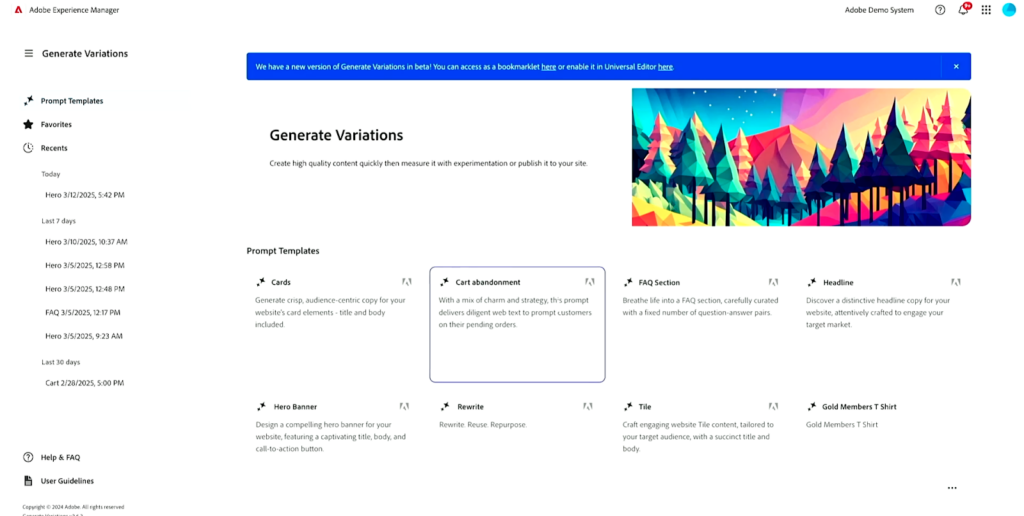
Merchants can simply enter a natural language prompt, and Firefly & Adobe Express will generate product descriptions, marketing copies, and visuals instantly. Whether for promotions, seasonal campaigns, or vast product catalogs, it will ensure a fast and consistent content creation process.
Here’s the interface it will come with. You can see how it accelerates the entire workflow of the content generation process.
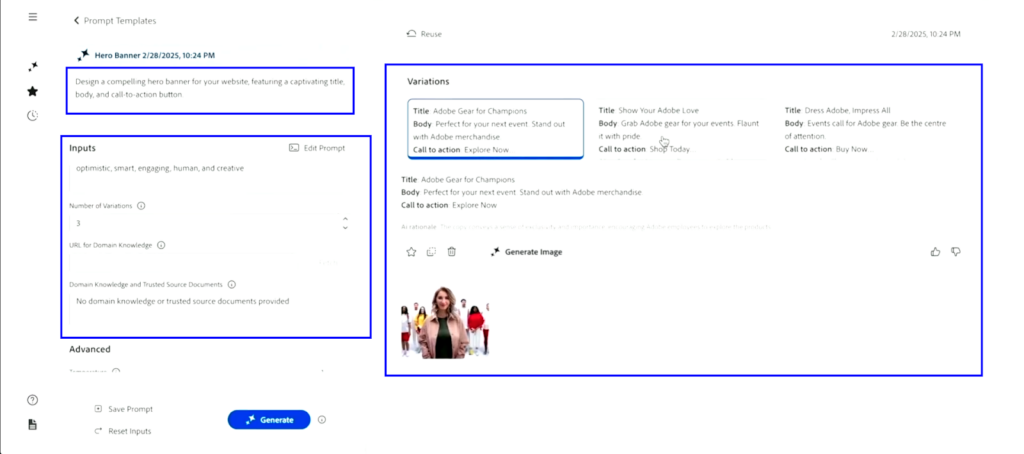
If we talk about how this advancement of generating content variations might apply to vast catalogs, it will still be easy.
To support large-scale personalization, Adobe Commerce SaaS provides centralized asset management, allowing merchants to:
- Search products by SKU, color composition, smart tags, and visual characteristics.
- Generate millions of content variations for different audiences.
- Publish unlimited personalized renditions, ensuring every visitor sees relevant content.
Moreover, ACCS is integrated with Adobe’s CDP (Customer Data Platform) that further improves the process of personalization. The tool helps analyze real-time customer behavior and preferences, allowing merchants to serve highly relevant content and product recommendations to each visitor.
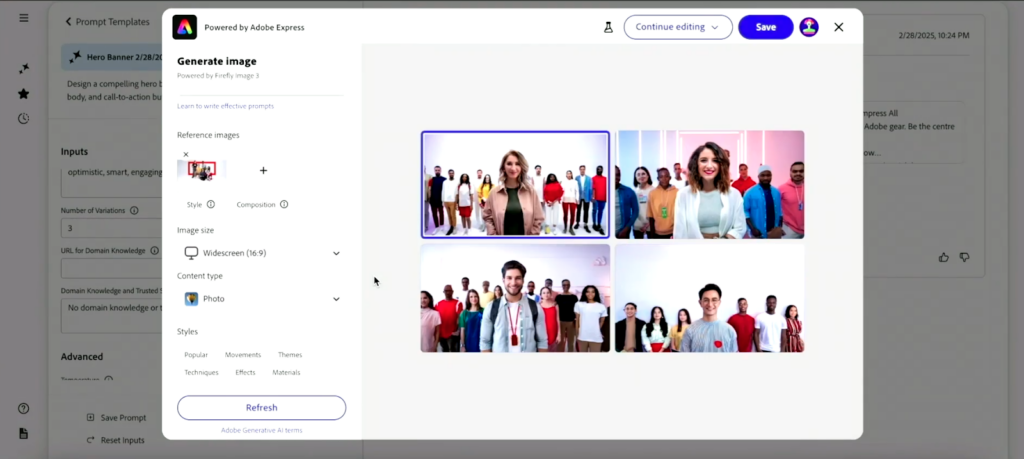
Let’s check an example of how they work together.
- CDP tracks this behavior and identifies the user as a potential buyer.
- GenAI (Firefly) then generates a custom banner featuring running shoes with a discount and a product description tailored for this shopper.
- This banner is then automatically displayed to the visitor.
With these AEM asset management capabilities and rich integrations, businesses can streamline the way they create, customize, and deliver content.
# Gen-AI-powered Content Automation
ACCS is pre-integrated with Agenctic AI where it helps automate the personalization process, making large-scale personalization more effortless. Businesses can now rely on Adobe Firefly’s GenAI for content generation, while Agentic AI automates the workflow to ensure the right content is delivered at the right time to the right audience.
# A/B Testing
Lastly, for content management, ACCS introduces the A/B testing capabilities to experiment with workflow within minutes under the same interface.

Every merchant wants to A/B test, however, it becomes tedious to rely on third-party platforms.
So, ACCS will allow you to test content variations from the same interface where you can test your content variants based on devices, location, audiences, and more. With that, merchants get an option to split traffic based on their preferences.
4. App Builder
Adobe Commerce SaaS comes with an app builder that helps merchants extend their store functionality through APIs and microservices. And it will no longer require modifications in Magento’s core.
Businesses can add features, automate workflows, or integrate with third-party apps without the risk of breaking core updates. Whether you want to create custom functionality for your store, simplify backend tasks, or want to improve the shopping experience for customers, the App Builder will help you do it. Also, these applications run outside of Magento’s core database, which is good for long-term stability, faster deployments, and better scaling.
5. Concept of Templates & Pre-built Components for Customization
With a traditional Magento setup, merchants need to install, configure, and troubleshoot extensions manually.
Adobe designed ACCS to make customization easy for merchants and developers. Instead of building everything from scratch, they introduced pre-built templates and components that let users get started quickly while keeping things flexible.
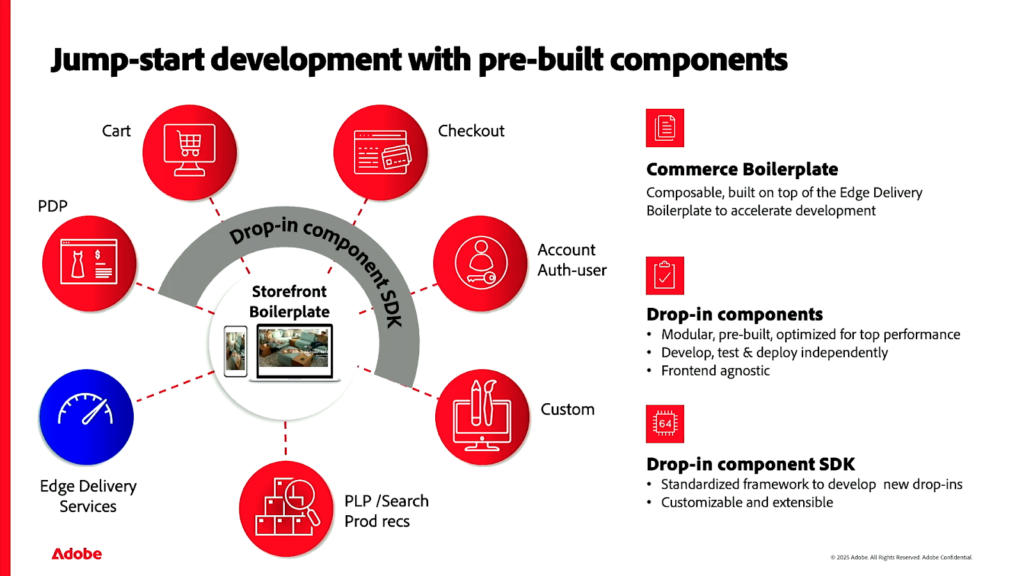
They have introduced a structured approach using boilerplates and pre-built components.
The boilerplate is a ready-made template that provides a solid foundation to start developing a storefront quickly, eliminating the need to configure everything manually.
And, to enhance flexibility, Adobe introduced drop-in components, which are pre-built, modular features like checkout, product pages, and search. These are optimized for performance, can be developed and deployed independently, and are frontend-agnostic, meaning they work seamlessly across different technologies.
What makes this system even more powerful is the addition of SDKs across both boilerplates and drop-ins.
With these, merchants and developers can create their own drop-in components or customize existing ones to fit their unique needs without disrupting the overall structure. The entire approach ensures that businesses can launch and scale quickly while still having the freedom to modify and enhance their commerce experience as required.
However, the new SaaS approach ensures seamless integration.
You can activate apps and extensions with minimal effort and the least amount of compatibility issues. Custom functionalities can be added through Adobe’s marketplace, or you can create your own solutions using APIs.
6. Scalability & Performance
With ACCS, Adobe hosts your websites on its servers.
The infrastructure is flexible so the resources will scale up and down dynamically based on the demand of traffic. This will prevent slow load times and site crashes during high-traffic events like holiday sales. Also, the overall performance of your store will be the responsibility of Adobe itself. So, performance will stay at its best.
7. Built-In Digital Asset Management (DAM)
Adobe Commerce as a Cloud Service is pre-integrated with AEM Assets, which is a Digital Asset Management tool by Adobe.
The integration with AEM Assets will bring built-in DAM capabilities directly into the platform.
This means merchants can manage all their digital assets (photos, videos, and more) without needing an external DAM solution. With this integration, users of ACCS will also benefit from Smart Imaging and Dynamic Media, which take asset management a step further.
- Smart Imaging automatically optimizes images based on device type, screen resolution, and network speed, ensuring faster load times without compromising quality.
- Dynamic Media enables the creation of rich, interactive visuals, such as zoomable images, 360-degree product views, and adaptive videos, enhancing customer engagement.
Overall, this will help ensure a seamless management and delivery of high-quality media across storefronts without complexity and easy access for merchandising, marketing, and personalization.
8. Composable & Headless Architecture
Adobe Commerce as a Cloud Service (ACCS) will follow composable and headless architecture.
With this API-driven approach, every component, the storefront, checkout, product catalog, payment system, and more will operate independently. This provides merchants with the flexibility to create unique eCommerce experiences without being restricted by a platform.
Merchants can mix and match different third-party solutions and customize their stores without altering the platform’s core.
Overall, ACCS will make sure that businesses aren’t locked into a single system but instead have the freedom to adapt, scale, and innovate at their own pace.
9. Advanced Catalog Management For Large-scale Commerce
With Adobe Commerce as a Cloud Service (ACCS), managing complex product catalogs will get easier and more efficient.
The system is designed to handle extensive product data where they ensure merchants can maintain highly scalable, organized, and adaptable catalogs without performance issues. ACCS enhances catalog efficiency through multiple advancements.
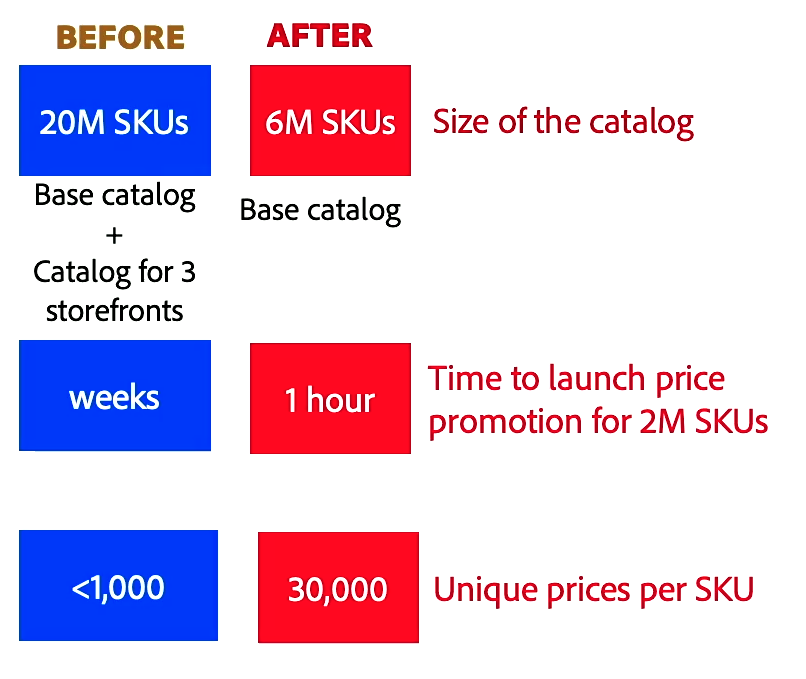
1# Scalability for Large Catalogs
ACCS supports up to 250 million SKUs in a single catalog, making it ideal for enterprises managing vast product inventories across multiple storefronts.
2# Flexible Pricing Structures
Businesses can define up to 30,000 unique price points per SKU, enabling more granular pricing strategies for different customer segments, locations, and promotions.
3# Lightning-Fast Price Updates
What once took weeks, such as launching a price promotion for 2 million SKUs, can now be done in just 1 hour. This rapid execution empowers merchants to respond quickly to market demands, seasonal campaigns, and competitive pricing adjustments.
4# Catalog Syndication Across Brands & Business Divisions
Merchants can easily syndicate product catalogs across different brands, business units, and geographic regions.
This means whether an enterprise operates in B2B, B2C, or hybrid models, ACCS enables businesses to manage product data from a centralized catalog while ensuring the right products reach the right audiences in each market.
Each storefront can have its own catalog, pricing, and localized product selection, so compliance and customer relevance is maintained.
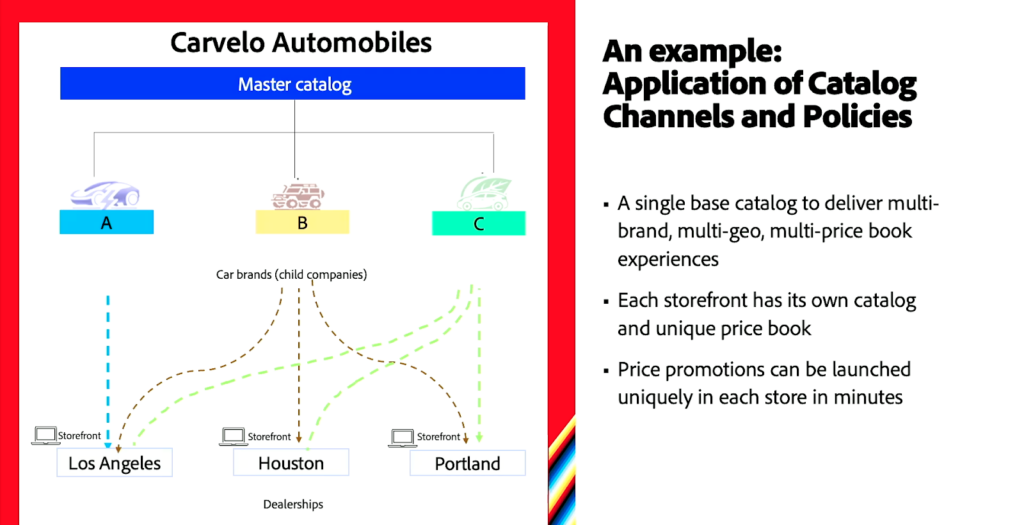
As shown in the example, you can see a master catalog for a large-scale enterprise with multiple brands.
However, they don’t sell the exact same cars at every dealership. Instead, they send specific products from catalogs to different locations based on what’s relevant for that region.
For example, a dealership in Los Angeles might get a different selection of cars and prices than one in Houston because customer demand, taxes, and other factors vary by location. This ensures that customers in each area see the most relevant products and prices without the business having to manually update everything for each store.
ACCS will automate the process, making it faster, more efficient, and a hassle-free solution to manage products across different storefronts.
10. B2B & B2C Functionalities
With Adobe Commerce Cloud Service, Adobe is bringing a suite of built-in B2B & B2C features to accelerate existing capabilities.
Traditionally, companies need to invest heavily in custom development, integrations, and infrastructure management, and ACCS will bring a lot of built-in functionalities to serve that issue.
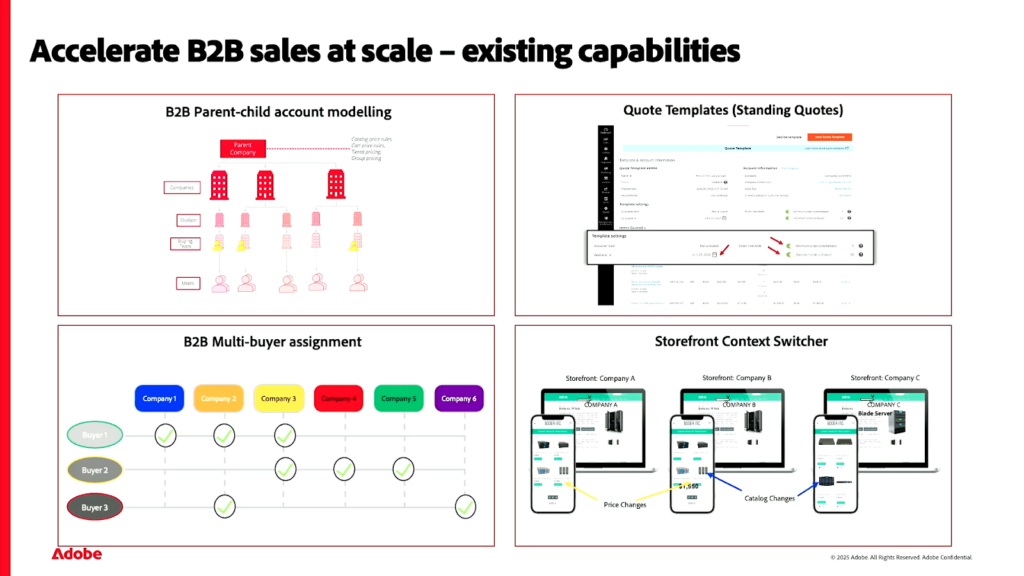
Here are B2B Capabilities in Adobe Commerce Cloud Services (ACCS):
- B2B Parent-Child Account Modeling – This supports hierarchical business structures with parent companies, divisions, buying teams, and users. Enables shared pricing rules and contract pricing.
- Quote Templates (Standing Quotes) – It will allow businesses to create and manage quote templates for faster and standardized negotiations.
- B2B Multi-Buyer Assignment – They will support multiple buyers per company with flexible role assignments.
- Storefront Context Switcher – ACCS enables quick switching between storefronts with price and catalog variations for different businesses.
Also, they shred light on B2B and B2C functionalities they will provide as built-in for sooner times.
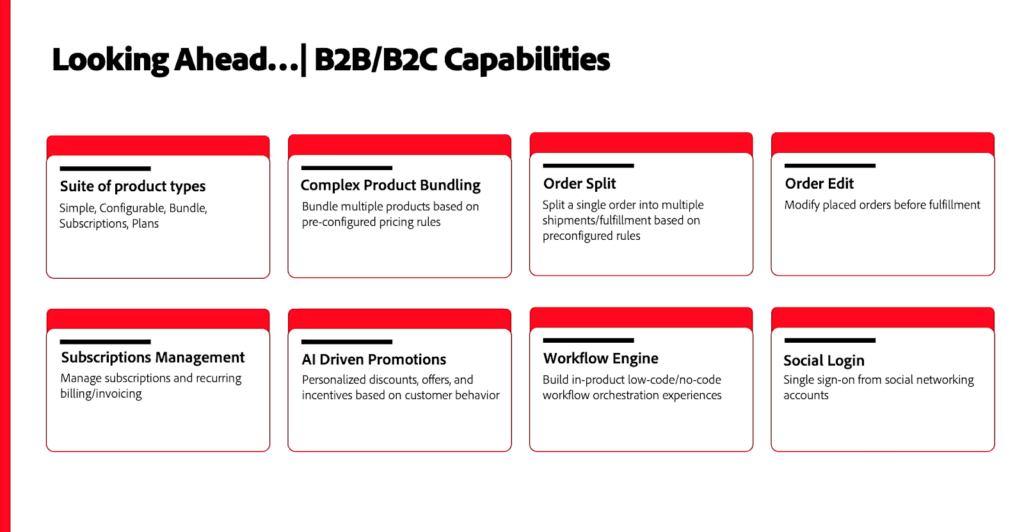
Upcoming B2B/B2C Capabilities in ACCS will include support for various product types, complex product bundling, order management features like order split and order edit, subscription management, AI-driven promotions, a low-code/no-code workflow engine, and seamless social login integration.
11. Security
The SaaS solution of Adobe will manage security on its own. Adobe integrates enterprise-grade security features like real-time threat detection, DDoS protection, and encrypted transactions, ensuring that customer data and business operations remain safe. It has a Web Application Firewall (WAF) for protection and the platform is PCI-compliant which guards it against common threats.
Additionally, SSL certificates and security configurations are handled automatically, ensuring every store is protected without requiring manual setup.
12. Dedicated Storefronts for Merchants
With Adobe’s SaaS solution, merchants get a dedicated storefront fully managed by Adobe’s cloud.
With that centralized backend, they can easily control their product catalog, branding, and customer experience without worrying about infrastructure or performance issues.
13. Inventory Management
ACCS will introduce a smart inventory management system where merchants can track product availability in real time, sync inventory across multiple sales channels, and set automated stock alerts to avoid overselling. The tool will include all the necessary functionality to handle multiple warehouses, manage pre-orders, set up custom stock rules, and more.
14. Shipping & Payment Solutions
ACCS will offer built-in shipping and payment integrations.
Merchants can connect with leading payment gateways like PayPal, Stripe, and Authorize.net without complex configurations. Additionally, shipping options are fully customizable, allowing businesses to set flexible shipping rates, offer real-time carrier calculations, and support international shipping.
15. Domain Management
Just as every SaaS solution, Adobe SaaS will allow easy domain integration and management within a few clicks. The cloud-based system allows businesses to connect, manage, and switch domains effortlessly.
16. Separate Customer & Order Control
ACCS allows businesses to manage customer data and orders independently across multiple storefronts or business units. This is particularly beneficial for B2B and multi-brand merchants who require distinct customer segments, pricing models, and checkout processes. Merchants can set up personalized user experiences, manage VIP customers differently from general shoppers, or create tailored promotions for specific groups.
Overall, the system ensures that orders, customer details, and transaction histories remain well-organized and easily accessible.
17. Automatic Updates & Maintenance
Lastly, Adobe handles all system upgrades, security patches, and performance enhancements automatically.
Unlike traditional Magento, where merchants had to schedule and test updates, ACCS ensures stores always run on the latest version without disruptions.
;
That’s all for the features of Adobe Commerce SaaS. And it shows that merchants are getting a lot with this SaaS offering.
But wait… what are the exact benefits? Let’s talk about it.
Benefits of Adobe Commerce SaaS (ACCS)
Here I’ve added details on the benefits coming along with the SaaS offering of Magento.
#1. Reduced Maintenance & Development Costs
The Adobe Commerce SaaS solution comes with subscription-based pricing. So, the costs will be predictable.
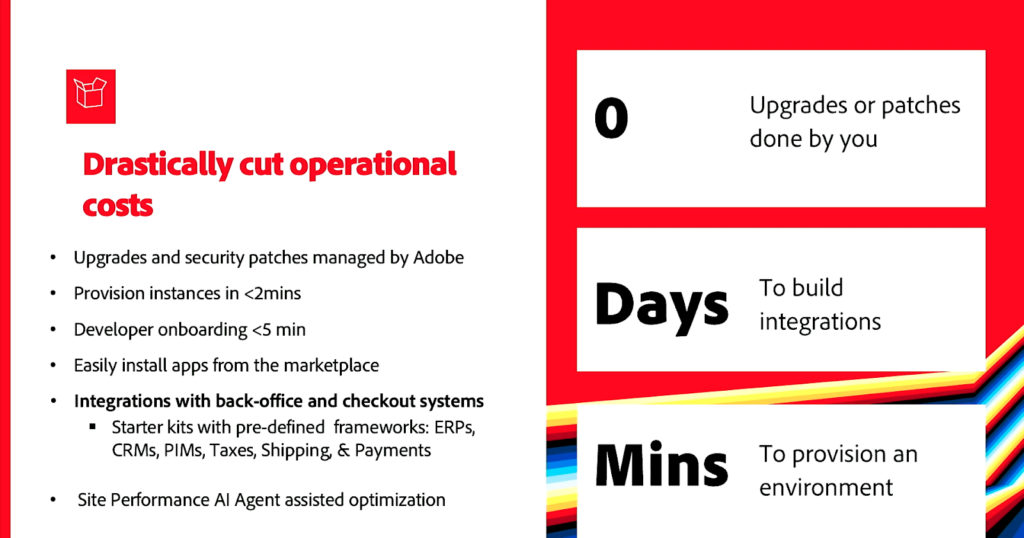
Also, ACCS no longer requires working on version upgrades, updates, security and performance optimizations, hosting, and more. And that also cuts a lot on expenses. There will be pre-defined frameworks for ERPs, CRMs, PIMs, Taxes, Shipping, and Payments which reduces the need for custom development and accelerates project timelines.
The system streamlines the onboarding process where they can onboard developers within 5 minutes, reducing delays, and improving productivity. Moreover, developers can quickly extend functionality by installing apps, rather than building features from scratch.
All of it all together helps a lot with costs.
#2. No More Manual Version Upgrades
The traditional Magento (Open Source or Adobe Commerce) requires merchants to upgrade & update their store to match the current versions or improvements. And that requires a lot of effort, testing, downtime, and expenses.
With Adobe Commerce SaaS, all the updates will be automated and there won’t be any downtime.
This offers ease to merchants where they don’t need to spend their resources on complex upgrade processes, allowing them to focus on sales and growth rather than technical maintenance.
#3. Easy Store Maintenance
Just as I mentioned, hosting, upgrades, patch installation, and all technical maintenance will be managed by Adobe, maintaining an online store with ACCS will get easier. Also, the app-based customization will bring out fewer compatibility issues, so you spend less time worrying about maintaining the technical side of the platform and more on business growth.
#4. Enterprise-Grade Security Without Any Hardwork
Security was always a concern with Magento as it required businesses to manage store security aspects on their own. However, with ACCS, Adobe manages all security updates, compliance standards, and threat monitoring, ensuring that stores remain protected against cyberattacks, data breaches, and vulnerabilities.
Also, it offers a lot of security features that are handled at the cloud level. So again, there won’t be any need for manual hard work. Adobe will take care of everything behind the scenes, allowing you to operate with peace of mind.
#5. No More Magento Performance Issues
Performance was another concern with traditional Magento (LUMA was the main issue).
With ACCS ecosystem performance issues like slow load times and server crashes are no longer a concern. Adobe’s cloud infrastructure automatically scales resources based on traffic demand. This ensures better performance even during high-traffic events like flash sales or holiday rushes.
Since Adobe handles caching, database optimization, and server management, merchants don’t need to work on troubleshooting performance aspects.
#6. A Complete Headless Setup
ACCS is fully headless. Merchants can build custom frontends while Adobe will manage the backend. This approach helps businesses focus on the core of business and Adobe will take platform side things as its own responsibility. Also, Luma or Hyva won’t work as frontend here.
You can use Adobe’s frontend experience or build your own custom storefront. This approach enables faster deployments, better performance, and a more flexible development process.
#7. Weekly Feature Releases
Unlike traditional Magento, where new features were introduced infrequently, Adobe SaaS promises a steady stream of updates with weekly feature releases.
This means merchants can continuously access new capabilities without ever needing to worry about major version upgrades, keeping their stores up-to-date with modern technology. Plus, these updates are designed to integrate seamlessly without causing disruptions.
#8. Reduced Reliance on Technical Teams
Since Adobe manages hosting, security, updates, and performance optimizations, merchants no longer need large technical teams to handle these tasks. With ACCS, there’s less need for backend developers to fix issues, apply patches, or manage infrastructure.
This allows businesses to focus on growth and operations rather than constantly dealing with technical challenges.
What Will Be the Use Cases of Adobe Commerce SaaS Offerings?
Adobe Commerce’s SaaS offerings open up a new world of possibilities for businesses looking to scale, optimize, and get modern at eCommerce operations.
Here’s how Adobe Commerce SaaS can be utilized across different business scenarios:
1 — Unified Solution for B2B & B2C Commerce Businesses
Adobe Commerce SaaS is designed to serve both B2B and B2C businesses running on Adobe Commerce.
With a cloud-based infrastructure, businesses can efficiently manage both B2B and B2C operations under one roof, all without worrying about performance or scalability. ACCS brings a lot of benefits for both B2B & B2C in terms of functionality, ease of use, and maintenance.
2 — Scalable Infrastructure for Enterprise-level Businesses
For enterprise businesses managing large-scale eCommerce operations, Adobe Commerce SaaS provides the reliability and flexibility needed to support growth. It offers built-in security, hyper personalization features, ensures compliance, and allows deep customization & integration with ERPs, CRMs, and other systems.
This helps enterprise-level businesses reduce their need to look out for the technical side and focus more on growth.
3 — Manageable Solution for Businesses Multiple Brands & Storefronts
Adobe Commerce SaaS simplifies managing multiple brands and storefronts, giving businesses complete control while maintaining distinct identities for each. Whether a fashion retailer running luxury, casual, and sportswear brands or a company catering to different markets, each storefront can have its own domain, branding, and inventory.
ACCS offers centralized management to improve operations.
This makes ACCS a great solution for businesses with multiple brands and storefronts that can scale effortlessly, maintain a consistent brand experience, and focus on growth instead of operational headaches.
;
With that, now you have a really vast amount of information on what exactly Adobe Commerce SaaS solution is bringing, how it benefits, and how it can be used.
But there are a few considerations that we haven’t mentioned yet. Let’s talk about that.
Challenges & Considerations Coming Along With Adobe SaaS Setup (ACCS)
Adobe Commerce SaaS offers a streamlined and fully managed solution.
However, the offerings are new and it does come with challenges and factors that you need to be well aware of before you think of making a switch to it.
(If not call them challenges, they can be stated as considerations. Just so you make a safe step toward it.)
1. It will Follow a Different Pricing Model
You already know that Magento Open Source is free to use and Adobe Commerce operates on a custom pricing model where the costs vary based on business size and revenue.
The Adobe SaaS setup will follow a subscription-based pricing model where the costs will be predictable.
But again, it won’t be budget-friendly for all businesses.
For now, pricing details for Adobe Commerce SaaS aren’t disclosed by Adobe. However, it’s understood that the cost structure is influenced by factors such as Gross Merchandise Value (GMV), Average Order Value (AOV), and specific business requirements.
(We’ll update it as soon as there’s an announcement from Adobe)
2. It comes with a Learning Curve
Every new technology comes with a learning curve and that stays the same for Adobe Commerce SaaS solutions too.
No matter the ease brought in by the platform, there will be a learning curve where merchants may need time to familiarize themselves with the admin panel and how to manage multiple storefronts efficiently.
It means that businesses switching to Adobe Commerce SaaS (ACCS) may need to invest time and effort in training their employees to use the platform effectively.
3. It has Potential Limitations
Adobe Commerce as a Cloud Service is designed to provide a scalable and managed environment. And in self-hosted versions of Magento, merchants, and developers had the flexibility to make changes in server infrastructure.
However, that part cannot be touched with ACCS, meaning, it will include certain limitations on deep customizations where it may not provide as much flexibility as before.
Limited access to core files can restrict developers who want to make extensive modifications. Additionally, merchants are dependent on Adobe for platform updates and maintenance, which means waiting for scheduled releases rather than making immediate changes.
What Does Adobe Commerce SaaS Announcement Mean for Existing Adobe Commerce Users?
If you’re an existing Adobe Commerce user on its PaaS platform (or on-premise), you might have questions about this platform shift.
However, there’s no impact to existing customer deployments for Adobe Commerce.
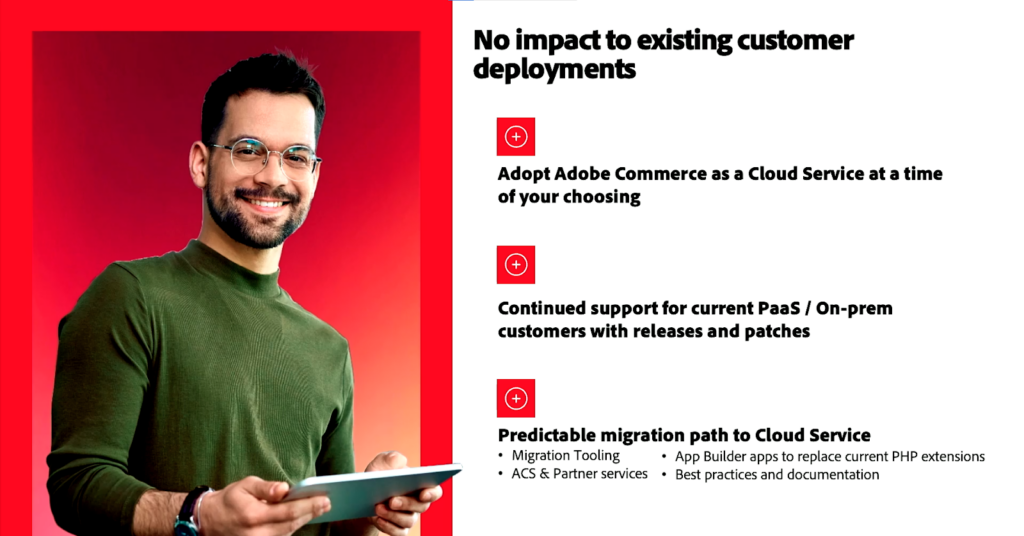
Adobe will provide you with the flexibility to join their Cloud Service when you choose to get it for your business.
Talking of support for Adobe Commerce, they will continue to support every PaaS and On-premise customer with quarterly releases of versions and patches that they’ve been doing for all these years. They haven’t put any end date for their support for the PaaS platform.
Also, Adobe has extended support for all the previous versions (2.4.4, 2.4.5, 2.4.6) to August 2026.
So, if you plan on upgrading in the future, you can consider adopting the Adobe SaaS platform. This provides you an option to choose Adobe Commerce as a Cloud Service instead of spending your resources on the new version, which is a more reliable platform for your business.
Additionally, they are making significant investments in improving the system. They’re developing for the better:
- Migration tools
- App Builder applications to replace existing PHP extensions
- Adobe Commerce Services (ACS) and partner ecosystem
- As well as the development of best practices and comprehensive documentation.
So, whenever, you as a merchant choose to join ACCS, the system will be there to help you at its best.
With that, let’s check on the migration process it will follow.
What Will Be the Migration Process To Adopt Adobe Commerce as a Cloud Service?
Migrating to Adobe Commerce as a Cloud Service will be easy and flexible as they offer two approaches to it.
- A phased migration to ACCS
- A direct migration to ACCS
This is because Adobe understands that adoption requires careful planning and decision-making. And that’s why they’ve made everything composable. So, as a merchant, you can choose how you want to migrate to this new Adobe SaaS platform.
Let’s learn more about both of these approaches to migrating to ACCS.
# A Phased Migration Approach to ACCS
For many businesses, a full migration overnight is impractical as they’ve vast catalogs, thousands of products, deep integrations with ERP & CRM systems, complex customizations, and high-volume data.
And making a move with all of it would take a significant amount of effort.
However, if they still want the benefits of Adobe Commerce SaaS, the solution is a phased migration process, made available by Adobe.
For a phased migration to ACCS, Adobe has launched a brand new product named “Adobe Commerce Optimizer” along with ACCS.
Here, we will check on what exactly Adobe Commerce Optimizer is, the purpose of launch, the phased migration process, and its benefits.
What Is Adobe Commerce Optimizer & Why Did Adobe Launch It?
Many businesses have deep integrations with ERP and CRM systems so changing the backend is quite difficult.
However, the challenge isn’t always the backend itself, it’s the limitations it imposes on catalog management and storefront personalization, ultimately affecting conversions.
To solve this, Adobe has announced Adobe Commerce Optimizer, an experience layer that works with any existing commerce backend.
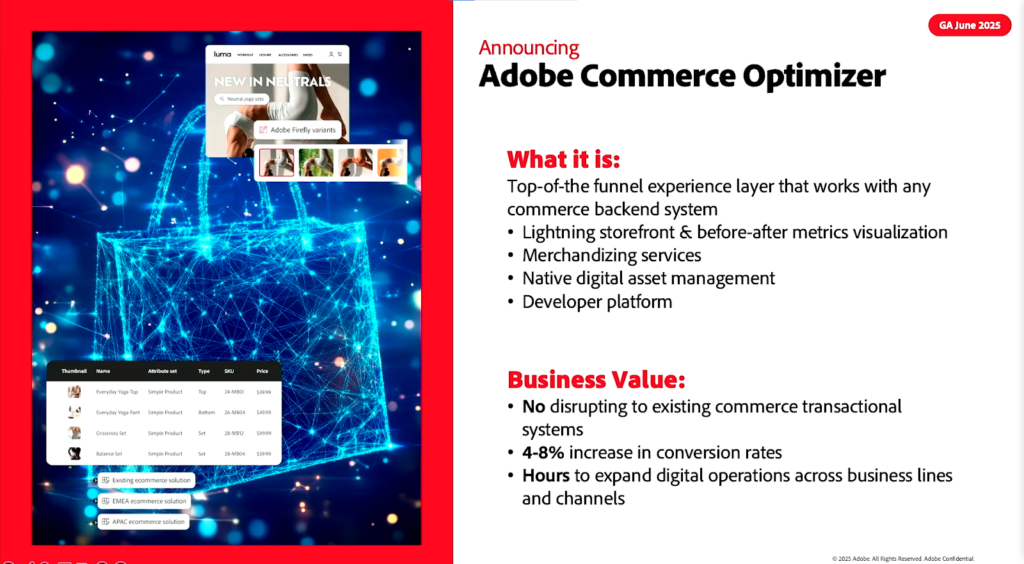
The Adobe Commerce Optimizer comes with the same storefront, merchandising services, developer platform, and digital asset management solution that of Adobe Commerce SaaS. Also, the platform is 100% SaaS, Composable, and Headless.
It promises better conversions and faster time to market without disrupting your existing commerce system.
Here’s the difference of ACCS and Adobe Commerce Optimizer to answer your doubts.
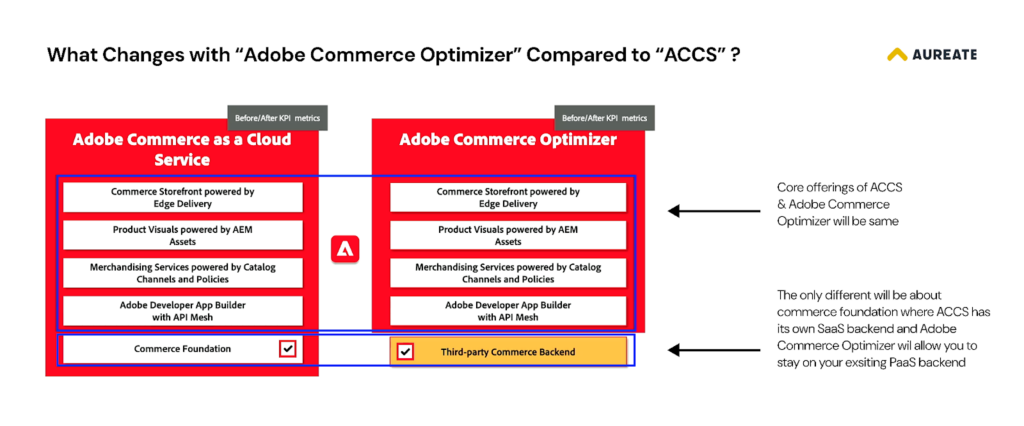
You can get all the benefits of Adobe SaaS while keeping your current backend, and it will be available starting June 2025.
So, instead of making a big move towards ACCS and achieving its benefits, businesses can stay with their current commerce backend and adopt Adobe Commerce Optimizer to access Adobe’s advanced storefront, merchandising, and personalization capabilities.
Overall, this product will help you gain the advantages of Adobe SaaS without disrupting your existing infrastructure.
;
That’s the idea of what Adobe Commerce Optimizer is. Now, let’s also check the phased migration process which involves it.
How Does the Phased Migration to ACCS Work?
First of all, phased migration is about flexibility where merchants get an option to first achieve half of the advance benefits of ACCS and then adopt it entirely as a platform. In the attached image below, you can see two steps to make a move towards ACCS.
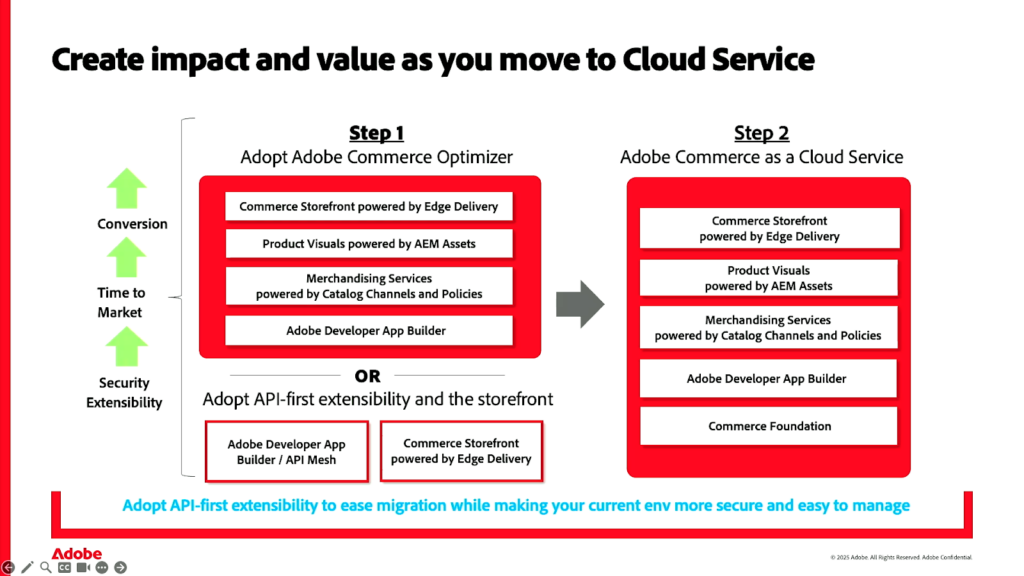
Let’s talk about them in detail.
Step 1: Adopt Adobe Commerce Optimizer
In the first phase, you can improve your current commerce setup by adopting Adobe Commerce Optimizer.
With that, you’ll achieve SaaS-like services without requiring a full migration from your PaaS-based backend. When you take this first step and invest in Adobe Commerce Optimizer, you get multiple components of Adobe SaaS with it, including:
1️⃣ A Storefront powered by Adobe Edge Delivery — for better performance & user experience
2️⃣ Adobe’s powerful AEM Assets — for managing and optimizing product images dynamically.
3️⃣ Merchandising Services (Catalog Channels & Policies) — to improve product discovery and personalization
4️⃣ Adobe Developer App Builder — for building and integrating custom features without backend complexity.
With this adoption, you can bring in all your customizations and integrations.
& here, you’ve got an option to start with an API-first approach only, which is an even shorter step compared to adopting these four components we mentioned above.
With this second option, you get an option to adopt:
1️⃣ The App Builder — This is where you start with a cloud-based integration framework that connects different systems (ERP, CRM, third-party apps) without complex custom development. It allows you to bring here all your integrations and customizations while staying on their existing PaaS platform.
2️⃣ A Storefront powered by Adobe Edge Delivery — to improve performance without overhauling the backend.
So, that’s about the options you get. You can either take full advantage of Adobe Commerce Optimizer or just the App Builder and its storefront.
Also, in the future, when you choose to make a move to ACCS entirely, you won’t be required to rework these elements, integrations, and customizations as they remain intact. And, every integration or customization that you bring here works on an API-first approach, which holds the benefit of better security and ease of maintenance.
The reason behind this phased approach is that you can take baby steps toward ACCS as per your will, see its impact for your organization, see the value, and then make a big move toward it.
With that, let’s get into step two.
Step 2: Full Migration to Adobe Commerce as a Cloud Service (ACCS)
Once your business is ready to move away from PaaS entirely, you can make a full transition to ACCS.
This step will bring you all the core benefits of ACCS.
- First, you get a complete cloud-native commerce backend with all core functionalities.
- Then, a scalable and SaaS infrastructure for lower maintenance.
- And, a seamless continuity of all previously integrated services, eliminating the need for additional migration effort.
That was it for the phased migration process towards ACCS.
The process, overall, helps your business minimize the risk factor, reduces the migration complexity, and provides an easier way to approach SaaS capabilities. All with faster time to market, security, and extensibility.
# A Direct Migration to ACCS
For businesses who are ready to fully embrace Adobe Commerce as a Cloud Service (ACCS), Adobe offers a direct migration path that enables a complete transition from a traditional PaaS (Platform-as-a-Service) model to a fully SaaS-based commerce infrastructure.
This approach provides a cloud-native, scalable, and low-maintenance solution, allowing businesses to focus on growth rather than infrastructure management.
;
Lastly, the transition from a PaaS-hosted environment to a fully managed SaaS platform enables greater scalability and reduced infrastructure maintenance. Customizations are rebuilt using Adobe Developer App Builder and API Mesh, ensuring all integrations remain flexible.
Also, the storefront and catalog will remain optimized using Edge Delivery for faster performance, AEM Assets for dynamic product visuals, and Catalog Policies for enhanced merchandising.
# Which Migration Approach Is Right For Your Business?
Here’s a structured comparison of both approach of migration to ACCS.
| Aspect | Phased Migration to ACCS | Direct Migration to ACCS |
| Approach | A gradual adoption of SaaS-based features while keeping the existing backend. And later, you make a full migration to Adobe SaaS | A full transition from PaaS to a SaaS-native environment. |
| Backend Impact | No immediate changes; businesses can retain their current Adobe Commerce backend. | A complete shift to ACCS, eliminating backend infrastructure management. |
| Customization Handling | Existing customizations remain while new ones can be built using API Mesh & App Builder. | All customizations must be reworked using SaaS-friendly tools like App Builder & API Mesh. |
| Integration Complexity | Integrations remain intact, reducing disruption. New integrations can be set up gradually. | Requires reworking integrations upfront but ensures a seamless future-proofed architecture. |
| Performance & Scalability | Gains SaaS benefits like Edge Delivery-powered storefront, without backend changes. | Fully optimized SaaS performance with auto-scaling and cloud-native architecture. |
| Migration Timeline | Flexible, businesses can migrate at their own pace. | Requires a single transition effort, completed in a shorter time frame. |
| Cost & Effort | Lower upfront cost and effort, as businesses migrate in steps. | Higher initial effort but lower long-term maintenance costs. |
| Best For | Large businesses with complex setups that want a low-risk transition. | Businesses looking for a complete modernization without managing infrastructure. |
And that helps you make a mind on what works best for your business model and requirements.
Should We Call It Magento 3, or Did Magento Simply Got Better?
Cannot call it Magento 3 as Adobe Commerce SaaS is not a version jump but a fundamental shift in how Magento operates.
With Commerce as a Service, Adobe is evolving Magento into a modern, SaaS-powered platform, bringing faster updates, better scalability, and seamless integrations without breaking changes.
So, it’s best to say that Magento has simply gotten better with the power of cloud services while maintaining the flexibility that merchants love.
CONCLUSION
Lastly, we hope you got the best of information on what exactly ACCS is and the benefits you can gain as your adopt it for your online store. You might still have alot of lingering questions around it.
And for that, we’ve added this FAQ section.
FAQs
1. What is Adobe Commerce as a Cloud Service?
Adobe just announced Commerce as a Service. This seemingly simple addition, “as a Service” solves Magento 2’s biggest pain points: complex upgrades, security concerns, and site performance. Simply, it’s Adobe’s new SaaS-based approach to eCommerce.
2. What is the key change in Commerce as a Service?
The main change is that the code now resides in a “black box” managed entirely by Adobe. This means merchants can no longer modify it directly, similar to Shopify’s infrastructure.
3. With ACCS, Is Magento Aiming to Be like Shopify?
Adobe Commerce Cloud Services (ACCS) is not aiming to be exactly like Shopify but rather to offer a flexible, enterprise-grade alternative with SaaS benefits while retaining Magento’s powerful customization and scalability.
Unlike Shopify’s closed ecosystem, ACCS retains enterprise flexibility, deep customization, and B2B capabilities while handling upgrades, security, and infrastructure like a SaaS platform.
It offers Shopify-like convenience without sacrificing Magento’s scalability and control.
4. What are the key implications of Commerce as a Service?
Commerce as a Service is a fully headless architecture, meaning the storefront and backend operate independently, allowing for greater flexibility in design and integrations. With Adobe managing the code and infrastructure, businesses no longer need to worry about security risks, performance issues, or maintenance overhead.
This ensures a stable, high-performance commerce environment.
Additionally, Adobe is restarting core development, enabling weekly feature releases that enhance functionality without introducing breaking changes, ensuring continuous innovation and smoother updates.
5. How does headless architecture of ACCS impact development?
With a fully headless approach, traditional Magento themes like Luma and Hyvä are no longer compatible. Instead, merchants can choose to use Adobe’s native frontend experience (powered by Edge Delivery) or build their own custom storefronts using modern frameworks.
This architecture enables faster deployments, greater flexibility, and an easier learning curve, as developers are no longer tied to Magento’s traditional theming system.
It also allows businesses to adopt best-in-class frontend technologies while maintaining a robust commerce backend.
6. What does ACCS controlling the infrastructure mean for merchants?
With ACCS managing the infrastructure, merchants no longer need to handle hosting, upgrades, security patches, or performance optimizations. This eliminates the burden of maintaining complex server environments, ensuring a secure, high-performance platform with automatic updates and optimizations—all handled by Adobe.
7. How does customization work under Adobe Commerce as a Cloud Service?
Customization in Adobe Commerce as a Cloud Service (ACCS) is API-driven, eliminating the need for direct code modifications.
Instead, businesses can extend functionality using App Builder, streamline integrations with API Mesh, and leverage Adobe Exchange Apps for pre-built solutions. The headless architecture allows full storefront customization with modern frameworks like React or Vue, ensuring flexibility without compromising performance, security, or scalability.
8. What if I need deep customizations with ACCS, like modifying order placement?
With ACCS, direct core code modifications aren’t possible, but merchants can still build custom workflows and functionalities using APIs. While this may require a different development approach, it ensures better security, stability, and long-term performance by keeping the platform optimized and upgradable without breaking changes.
9. What does ACCS mean for current Adobe Commerce users?
Current Adobe Commerce users don’t need to make immediate changes, but to stay future-proof, their development approach should evolve. Agencies should start using React for frontend customizations and leveraging Adobe App Builder for new features to ensure seamless adoption of ACCS capabilities over time.
If you still have any queries or questions, our Magento experts are happy to consult you.






Post a Comment
Got a question? Have a feedback? Please feel free to leave your ideas, opinions, and questions in the comments section of our post! ❤️